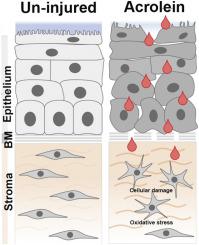当前位置:
X-MOL 学术
›
Toxicol. Lett.
›
论文详情
Our official English website, www.x-mol.net, welcomes your
feedback! (Note: you will need to create a separate account there.)
Glutathione is a potential therapeutic target for acrolein toxicity in the cornea
Toxicology Letters ( IF 2.9 ) Pub Date : 2021-04-01 , DOI: 10.1016/j.toxlet.2021.01.005 Suneel Gupta 1 , Sabeeh Kamil 1 , Prashant R Sinha 1 , Jason T Rodier 2 , Shyam S Chaurasia 1 , Rajiv R Mohan 3
Toxicology Letters ( IF 2.9 ) Pub Date : 2021-04-01 , DOI: 10.1016/j.toxlet.2021.01.005 Suneel Gupta 1 , Sabeeh Kamil 1 , Prashant R Sinha 1 , Jason T Rodier 2 , Shyam S Chaurasia 1 , Rajiv R Mohan 3
Affiliation

|
Toxic and volatile chemicals are widely used in household products and previously used as warfare agents, causing a public health threat worldwide. This study aimed to evaluate the extent of injury and mechanisms of acrolein toxicity in the cornea. Primary human corneal stromal fibroblasts cultures (hCSFs) from human donor cornea were cultured and exposed to acrolein toxicity with -/+ N-acetylcysteine (NAC) to study the mode of action in the presence of Buthionine sulphoximine (BSO). PrestoBlue and MTT assays were used to optimize acrolein, NAC, and BSO doses for hCSFs. Cell-based assays and qRT-PCR analyses were performed to understand the acrolein toxicity and mechanisms. Acrolein exposure leads to an increased reactive oxygen species (ROS), compromised glutathione (GSH) levels, and mitochondrial dysfunction.The TUNEL and caspase assays showed that acrolein caused cell death in hCSFs. These deleterious effects can be mitigated using NAC in hCSFs, suggesting that GSH can be a potential target for acrolein toxicity in the cornea.
中文翻译:

谷胱甘肽是角膜丙烯醛毒性的潜在治疗靶点
有毒和挥发性化学品广泛用于家用产品中,并且以前被用作战剂,对全世界的公共健康造成威胁。本研究旨在评估角膜损伤程度和丙烯醛毒性机制。培养来自人供体角膜的原代人角膜基质成纤维细胞培养物 (hCSF),并使其暴露于含有 -/+ N-乙酰半胱氨酸 (NAC) 的丙烯醛毒性,以研究丁硫氨酸亚磺酰亚胺 (BSO) 存在下的作用模式。 PrestoBlue 和 MTT 测定用于优化 hCSF 的丙烯醛、NAC 和 BSO 剂量。进行基于细胞的测定和 qRT-PCR 分析以了解丙烯醛的毒性和机制。丙烯醛暴露会导致活性氧 (ROS) 增加、谷胱甘肽 (GSH) 水平受损和线粒体功能障碍。TUNEL 和半胱天冬酶检测表明丙烯醛导致 hCSF 中的细胞死亡。在 hCSF 中使用 NAC 可以减轻这些有害影响,这表明 GSH 可能是角膜中丙烯醛毒性的潜在目标。
更新日期:2021-04-01
中文翻译:

谷胱甘肽是角膜丙烯醛毒性的潜在治疗靶点
有毒和挥发性化学品广泛用于家用产品中,并且以前被用作战剂,对全世界的公共健康造成威胁。本研究旨在评估角膜损伤程度和丙烯醛毒性机制。培养来自人供体角膜的原代人角膜基质成纤维细胞培养物 (hCSF),并使其暴露于含有 -/+ N-乙酰半胱氨酸 (NAC) 的丙烯醛毒性,以研究丁硫氨酸亚磺酰亚胺 (BSO) 存在下的作用模式。 PrestoBlue 和 MTT 测定用于优化 hCSF 的丙烯醛、NAC 和 BSO 剂量。进行基于细胞的测定和 qRT-PCR 分析以了解丙烯醛的毒性和机制。丙烯醛暴露会导致活性氧 (ROS) 增加、谷胱甘肽 (GSH) 水平受损和线粒体功能障碍。TUNEL 和半胱天冬酶检测表明丙烯醛导致 hCSF 中的细胞死亡。在 hCSF 中使用 NAC 可以减轻这些有害影响,这表明 GSH 可能是角膜中丙烯醛毒性的潜在目标。









































 京公网安备 11010802027423号
京公网安备 11010802027423号